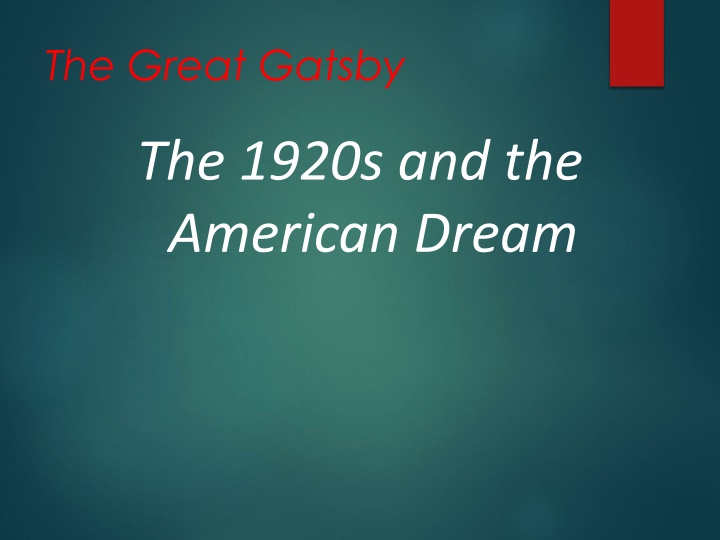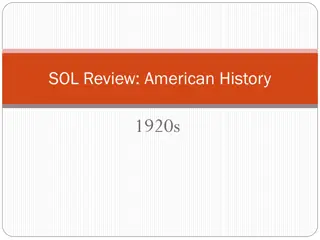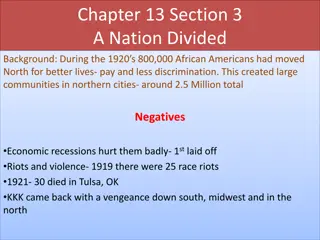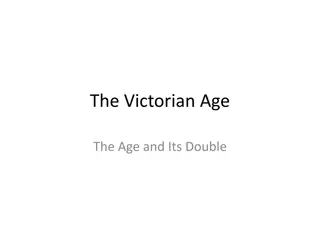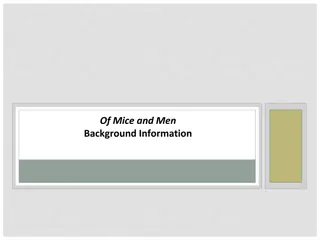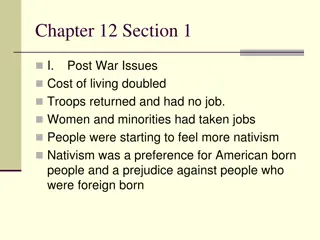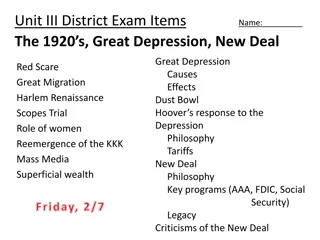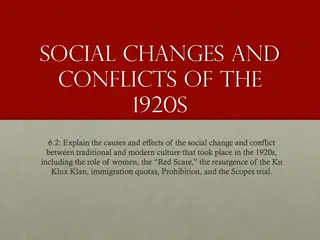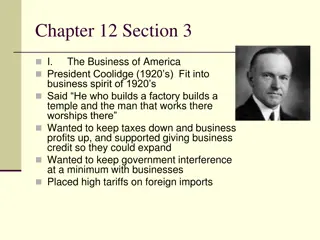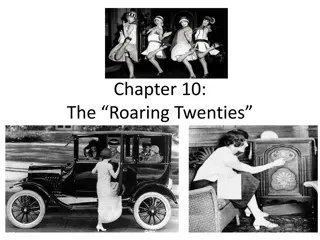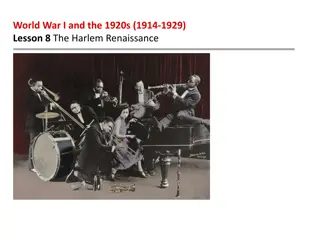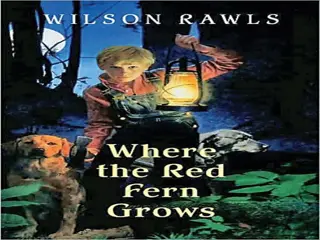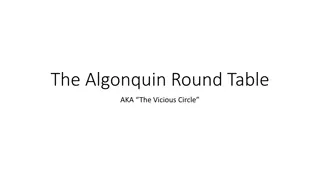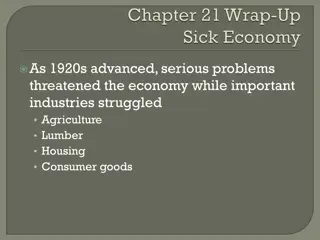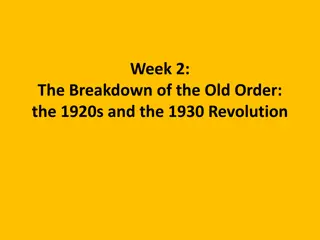The 1920s: A Decade of Transition and Contrasts
The 1920s in America were a time of significant change and contradictions, marked by the aftermath of World War I, economic boom, social unrest, and cultural shifts. The era saw booming economy, rise of organized crime, implementation of Prohibition, and societal changes in morals and attitudes. Despite the optimism and progress, critics noted a decline in values and disillusionment among Americans, leading to a complex social atmosphere of change. The decade showcased urbanization, jazz music, cinema development, and increased mobility, while also grappling with issues like prohibition and materialism.
Download Presentation

Please find below an Image/Link to download the presentation.
The content on the website is provided AS IS for your information and personal use only. It may not be sold, licensed, or shared on other websites without obtaining consent from the author.If you encounter any issues during the download, it is possible that the publisher has removed the file from their server.
You are allowed to download the files provided on this website for personal or commercial use, subject to the condition that they are used lawfully. All files are the property of their respective owners.
The content on the website is provided AS IS for your information and personal use only. It may not be sold, licensed, or shared on other websites without obtaining consent from the author.
E N D
Presentation Transcript
The Great Gatsby The 1920s and the American Dream
The 20s: an age of transition World War I and After "The world must be made safe for democracy" Woodrow Wilson the President had declared, "Its peace must be planted upon the tested foundation of political liberty." --- a spirit of idealism Americans entered the war in 1917. a general disillusionment among the people which caused nervousness: racism, intolerance, violence, Ku Klux Klan, immigrants, political intolerance "ghost of bolshevism" behind every form of social protest/ strikes. 1922 foreign policy of Isolationism 1929 Stock Market Crash 1932 New Deal era
Roaring Twenties Economy booming America partied Organized crime Prohibition Act Decline of moral standards
OPTIMISM business, change and innovation, laissez faire- economy rapid growth of industry and mechanization: unlimited progress effecting an even wider distribution of the blessing of civilizations : electricity; automobile even skeptics believe in progress and in solving of problems: new" Golden Age" for America
CRITICS they called the decade "decline and degradation" Americans are caught up in a "surge of materialism", people who had failed to grasp the meaning and significance of life. they feel disillusioned or disenchanted, they lost faith in life and in the possibility of social progress that caused their absolute lack of interest in politics.
SOCIAL ATMOSPHERE OF CHANGE relaxing of structures within the sphere of private and public morality relationship between the sexes change of the status of women
SPIRIT OF THE 20s urbanization and the move away from the land fascination with the dream of success development of the cinema as a medium of entertainment popularity of jazz increased mobility brought about by the mass produced automobile
PROHIBITION the 18th Amendment(1919)prohibited the sale and consumption of alcohol. although alcohol was illegal it was distributed through" bootleggers" bootlegging means the production and sale of liquor. alcohol was served in illegal night-clubs which were called "speakeasies" it was the time of famous gangsters like Al Capone and events like the St. Valentine's Day massacre happened. During that time the Mafia became important in American society.
THE CHANGING ROLE OF WOMEN The 19th Amendment(1920) gave women the right to vote. during the Twenties 9 million women were employed and earned money on their own, many younger women used their money to enjoy themselves they were able to drink and smoke in public. For the first time female alcoholism is a major problem. the liberated young women were called" flappers" In The Great Gatsby Jordan Baker is such a new type of woman. She is living alone and has equal relationships to men. She is self-confident in dealing with others. Tom comments on her new freedom as a woman.
FACTS ABOUT THE DECADE 106,521,537 people in the United States 2,132,000 unemployed, Unemployment 5.2% Life expectancy: Male 53.6, Female 54.6 343.000 in military (down from 1,172,601 in 1919) Average annual earnings $1236; Teacher's salary $970 Illiteracy rate reached a new low of 6% of the population. Gangland crime included murder, swindles, racketeering It took 13 days to reach California from New York
Who is F. Scott Fitzgerald? Born in 1896, in St. Paul, Minnesota. He attended Princeton University. 1917 joined the army. Met his wife Zelda. Published The Great Gatsby at 23 in 1925. Regarded as the speaker of the Jazz Age. Drinking and wife s schizophrenia Died in 1940.
WHAT IS THE AMERICAN DREAM? It describes an attitude of hope and faith that looks forward to the fulfillment of human wishes and desires. We hold these truths to be self- evident, that all men are created equal, that they are endowed by their creator with certain unalienable rights, that among these are life, liberty, and the pursuit of happiness.
SPIRITUAL AND MATERIAL IMPROVEMENT Materialism achieved too quickly. Thus, lacking spiritual life/purpose. Gatsby is a character that represents this DREAM.
FAILURE OF THE AMERICAN DREAM Poverty Discrimination Exploitation Hypocrisy Corruption suppression
How is this developed? Through the 5 central characters Through certain dominant images and symbols Through diction.
The Roaring 20s: A Brief but Comprehensive Introduction
The 1920s Known by names such as the Jazz Age, the Age of Intolerance, and the Age of Wonderful Nonsense The age that embodies the beginning of Modern America. Post WWI and after pulling through a worldwide Flu epidemic many American s felt hemmed up and the new decade would be a time of change for everyone---not always in a good way.
1920s: Political Herbert Hoover was elected to the presidency in 1928. Popular with the people. He was raised up by the country's prosperity until the beginning of the Great Depression began to carve its trough into the nation's economy early on his presidency.
1920s: Social Red Scares refer to the fear of Communism in the U.S. just before and during the 1920s Historians often point out that Americans had withdrawn into a provincialism as evidenced by the reappearance of the Ku Klux Klan, restrictive immigration laws, and Prohibition the 18th amendment banning the manufacturing, sale and transport of intoxicating liquor.
1920s: Social However, many people disliked the law and imbibed in unlawful nightclubs called speakeasies. Gangsters took control of bootlegging (illegal distribution of liquor) and violent lawlessness erupted. Lacking public support, the federal government was virtually unable to enforce Prohibition.
1920s: Social Youthful "Flapper" women provoked older people with brief skirts, bobbed hair, and cavalier use of makeup and cigarettes. Social crazes such as dances like the Charleston, dance marathons, flagpole sitting and flying stunts erupted. Babe Ruth and other sports figures became heroes.
1920s Arts & Writing The lush, ornate style of Art Deco architecture, art, clothing, hairstyles, decor and furnishings flourished The Harlem Renaissance a rich period of American writing Sinclair Lewis, Willa Cather, William Faulkner, F. Scott Fitzgerald, Carl Sandburg and Ernest Hemingway were prominent writers of the time period Will Durant's The Story of Philosophy would sell millions of copies.
http://upload.wikimedia.org/wikipedia/commons/thumb/f/fc/Chrysler_Building_at_night.JPG/125px-Chrysler_Building_at_night.JPGhttp://upload.wikimedia.org/wikipedia/commons/thumb/f/fc/Chrysler_Building_at_night.JPG/125px-Chrysler_Building_at_night.JPG See full size image See full size image
1920s Arts & Writing A uniquely American music form, with roots in African expression, came to be known as jazz greats such as Louis Armstrong, Duke Ellington and Fletcher Henderson George Gershwin, Cole Porter and others would bring jazz influences to Broadway and the concert hall. Bessie Smith hallowed the Blues on a sound recordings. first movie made with sound, The Jazz Singer, starring Al Jolson
Count+Basie Bessie_Smith_8120660 duke charlie-chaplin seth-rudetsky-8-cole-porter gershwin RudolphValentino
F. Scott Fitzgerald Born September 24th, 1896 in St.Paul Minnesota 1911-1912 attended Newman, a Catholic prep school in NJ Went on to Princeton University Class of 1917 Was on academic probation so he left school and joined the Army in his intended year of graduation
F. Scott Fitzgerald While stationed in Alabama in 1918 he met and fell in love with his future wife Zelda Sayre 1919 is discharged from the Army Married Zelda 1920 after he earned recognition for his work, This Side of Paradise The two embark on an extravagant lifestyle that would lead to the trials and tribulations of both their lives and their relationship
F. Scott Fitzgerald Fitzgerald becomes affluent with his play The Vegetable in 1922 By this time he is an alcoholic, it is documented that he always wrote sober alcohol had become a major part of how he lived his life His wife would often get tight (drunk) but was not known as an alcoholic
F. Scott Fitzgerald The two moved frequently and lived in several places including: France, Alabama, Baltimore and Asheville, North Carolina. Many of these places are where Zelda would receive treatments for her mental disorders By 1931 Fitzgerald s writing was an off and on practice because he was trying to take care of his ailing wife By 1936 the marriage was virtually over and Zelda moved permanently to Highland Hospital
F. Scott Fitzgerald In 1937 Fitzgerald tries his hand in Hollywood where he signed with MGM Studios and works until late 1938 Fitzgerald believed himself to be a failure He became more notably recognized post-humously His 1924 work, The Great Gatsby has secured him a place in American History being called the example that defines the classic American novel
The Great Gatsby 1924 F. Scott Fitzgerald Modernist Novel; a novel of manners
The Great Gatsby Setting: The Summer of 1922 on Long Island and in New York City THEMES: The idea of the American Dream The spirit revolving around the 1920 s Social classes The idea of symbols Past, present and future
